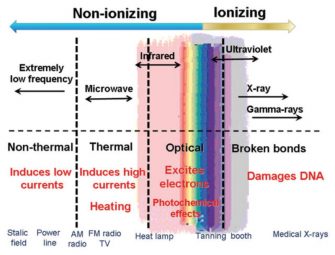Infrared Therapy – Lighting Up Pain Management
 It is expected that we’ll all experience pain from time to time. Pain can be a vital protective sensation. If a person touches a hot stove, the immediate pain causes them to move their hand at once, preventing a serious burn. Likewise, the sensation of a knife cutting skin produces an immediate reaction, preventing a more serious cut. In these cases, the pain triggers a response to prevent further injury.
It is expected that we’ll all experience pain from time to time. Pain can be a vital protective sensation. If a person touches a hot stove, the immediate pain causes them to move their hand at once, preventing a serious burn. Likewise, the sensation of a knife cutting skin produces an immediate reaction, preventing a more serious cut. In these cases, the pain triggers a response to prevent further injury.
In other cases, pain serves as a warning that something is wrong. Sudden pain in the abdomen may signal an infection in the appendix or a kidney stone. However, in some cases, pain can continue for an extended period time – not just hours or days, but months or years.
Pain that lasts 3 months or more is referred to as chronic pain. It can be constant or come and go, affecting any part of the body. While it may originate from an illness or injury, chronic pain occurs when pain lasts long after the normal recovery time. In some cases, there is no obvious cause, making it even harder to treat.
Due to its nature, chronic pain can become an obstacle to normal activities, social life and even the ability to care for oneself or others. This can lead to depression, anxiety and/or trouble sleeping – any of which can make pain worse, creating a vicious cycle.
While medications were once thought to be a solution for patients experiencing chronic pain, many of those that were once considered “miracle drugs” are now known to have significant dangerous side effects and high risk of addiction. This has sent providers and patients back to the drawing board in a search for a safe solution for pain management.
One therapy being used today is infrared (IR) energy. Infrared therapy is a light-based method used to treat pain and inflammation for various parts of the body. Unlike ultraviolet light, which can damage the skin, it is known to have the ability to penetrate deeper layers of the skin to provide pain relief.
The chart below, published in a report in Photonics Lasers Med (Nov. 2012), shows how infrared rays fall on the spectrum of electromagnetic radiation. Infrared (IR) radiation has wavelengths between 760 nm and 100,000 nm and can further be divided into 3 subcategories based on wavelength.
- Near infrared 700-1400nm
- Mid infrared 1400-3000nm
- Far infrared 3000-100,000nm

It’s interesting to note, the concept of using light for medicinal purposes is not new. Heliotherapy (exposure to sunlight) was used in treating various diseases by Hippocrates and ancient physicians, Ephesus and Avicenna.
After the invention of the light bulb, Danish physician Niels Ryberg Finson began studying the effect light has on living organisms. He developed the first light therapy in 1896 to treat a type of tuberculosis. His treatments were successful in helping many patients and he was awarded the Nobel Prize in Physiology in 1903 “in recognition of his contribution to the treatment of diseases, especially lupus vulgaris, with concentrated light radiation, whereby he has opened a new avenue for medical science.” Since then, our knowledge of how various forms of light can be used to affect the human body has grown exponentially.
IR has been shown to have positive effects on the human body, demonstrated in a 2006 randomized, controlled trial. With low back pain being the most prevalent musculoskeletal disability, researchers chose to evaluate to what degree IR could improve this condition. The method they focused on was a portable IR therapy device that was designed to be worn as a belt that converts electrical energy to IR energy at 800 nm to 1200 nm.
Forty patients of an Ontario pain management clinic, ranging from 26-80 years of age and with an average duration of low back pain for 6 ½ years, took part in the study. All patients were receiving other therapy for chronic pain and their medications (21 were on opioids), and nerve blocks were continued as scheduled during the study. One patient dropped out of the placebo group, leaving 21 who received IR therapy and 18 receiving the placebo.
They attended weekly sessions where they rated pain on the numerical rating scale (NRS). The pain was assessed overall pain (standing still), pain bending forward, pain bending backward, pain rotating right, pain rotating left, pain bending right and pain bending left.
The placebo group did have a small decrease in pain levels (7.48 down to 6.02). However, the IR therapy group showed “a progressive decline in pain levels of approximately 50%” (6.94 down to 3.05)! The decline was greater as the study went on. The researchers concluded: “the IR therapy unit used was demonstrated to be effective in reducing chronic low back pain, and no adverse effects were observed.”
The field of IR for pain management is relatively new and rapidly growing and newer research has shown IR’s benefits for treating multiple types of pain are very promising.
A 2017 Korean study reported: “near-infrared ray LED belt was effective in reducing menstrual pain, menstrual pain duration compared to the use of analgesics”.
Findings from a 2020 Taiwanese study involving diabetic patients undergoing hemodialysis concluded: “Significant positive effects of FIR therapy on temperature, pulse, and blood flow of the dorsalis pedis artery were observed.” Additionally, the experimental group reported improvement in sensitivity to pain, tactility, and pressure as well as reductions in soreness, tingling, and coldness in the feet.
A 2021 study published in Neurology India found that among subjects with painful diabetic peripheral neuropathy (DPN), Monochromatic infrared energy (MIRE) provided “symptomatic benefit” and improvement in quality of life.
These studies, and many more, are demonstrating that IR can be used to produce positive changes in the human body, including pain relief, with low risk of side effects. Research continues to explore conditions that could be treated with IR and better methods of conducting the therapy such as clothing materials that can transform heat energy from the body to IR energy as well as plaster and ceramic powder that can be used to emit therapeutic IR waves.
By utilizing effective, drug-free treatments such as IR, many patients can experience pain relief safely, without risk of addictive pain medications. Chiropractors are trained to use chiropractic adjustments, as well as modalities such as IR, to help the patient achieve pain relief safely. Talk to your doctor of chiropractic about treatments that may help you find relief and improve your overall wellness.
References:
Cleveland Clinic “Chronic Pain” https://my.clevelandclinic.org/health/diseases/4798-chronic-pain accessed 9/12/22
Gale GD, Rothbart PJ, Li Y. Infrared therapy for chronic low back pain: a randomized, controlled trial. Pain Res Manag. 2006 Autumn;11(3):193-6. doi: 10.1155/2006/876920. PMID: 16960636; PMCID: PMC2539004.
Lee JM, Kim KH. Effect of near-infrared rays on female menstrual pain in Korea. Nurs Health Sci. 2017 Sep;19(3):366-372. doi: 10.1111/nhs.12356. Epub 2017 Jul 7. PMID: 28686000.
Wang YH, Cheng FY, Chao YC, Liu CY, Chang Y. Effects of Far-Infrared Therapy on Foot Circulation Among Hemodialysis Patients With Diabetes Mellitus. Biol Res Nurs. 2020 Jul;22(3):403-411. doi: 10.1177/1099800420923730. Epub 2020 May 5. PMID: 32367734.
Rastogi A, Uppula P, Saikia U, Bhansali A. Effect of Monochromatic Infrared Energy on Quality of Life and Intraepidermal Nerve Fiber Density in Painful Diabetic Neuropathy: A Randomized, Sham Control Study. Neurol India. 2021 Sep-Oct;69(5):1331-1337. doi: 10.4103/0028-3886.329614. PMID: 34747807.
Vatansever F, Hamblin MR. Far infrared radiation (FIR): its biological effects and medical applications. Photonics Lasers Med. 2012 Nov 1;4:255-266. doi: 10.1515/plm-2012-0034. PMID: 23833705; PMCID: PMC3699878.
Tsai SR, Hamblin MR. Biological effects and medical applications of infrared radiation. J Photochem Photobiol B. 2017 May;170:197-207. doi: 10.1016/j.jphotobiol.2017.04.014. Epub 2017 Apr 13. PMID: 28441605; PMCID: PMC5505738.
Theralight. “A Brief History of Red Li8ght Therapy” https://www.theralight.com/a-brief-history-of-red-light-therapy/ accessed 9/12/22
Gupta, Nishant. Ancient Light Therapies: A Boon to Medical Science. Research Gate. July 2018.
The Nobel Prize. Niels Ryberg Finsen Facts https://www.nobelprize.org/prizes/medicine/1903/finsen/facts/ accessed 9/12/22